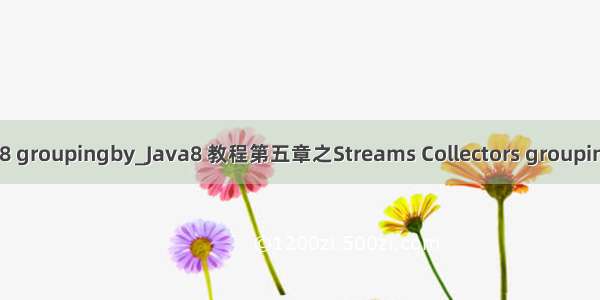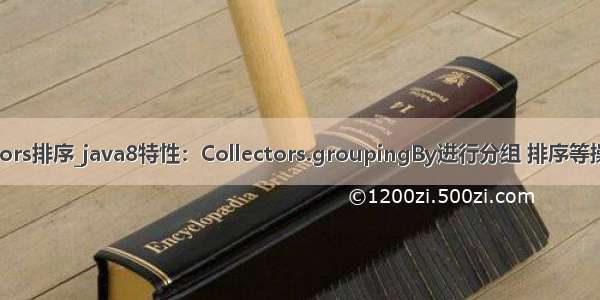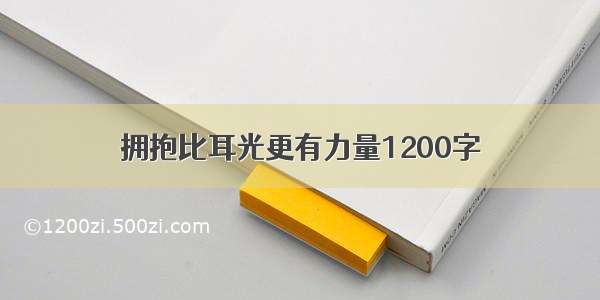
目录
1、数据准备:
2、分组
按照类目分组:
按照几个属性拼接分组:
根据不同条件分组
3、多级分组
4、按子组收集数据
求总数
求和
把收集器的结果转换为另一种类型
联合其他收集器
Collectors.groupingBy根据一个或多个属性对集合中的项目进行分组
1、数据准备:
public Product(Long id, Integer num, BigDecimal price, String name, String category) {this.id = id;this.num = num;this.price = price;this.name = name;this.category = category;}Product prod1 = new Product(1L, 1, new BigDecimal("15.5"), "面包", "零食");Product prod2 = new Product(2L, 2, new BigDecimal("20"), "饼干", "零食");Product prod3 = new Product(3L, 3, new BigDecimal("30"), "月饼", "零食");Product prod4 = new Product(4L, 3, new BigDecimal("10"), "青岛啤酒", "啤酒");Product prod5 = new Product(5L, 10, new BigDecimal("15"), "百威啤酒", "啤酒");List<Product> prodList = Lists.newArrayList(prod1, prod2, prod3, prod4, prod5);
2、分组
按照类目分组:
Map<String, List<Product>> prodMap= prodList.stream().collect(Collectors.groupingBy(Product::getCategory));//{"啤酒":[{"category":"啤酒","id":4,"name":"青岛啤酒","num":3,"price":10},{"category":"啤酒","id":5,"name":"百威啤酒","num":10,"price":15}],"零食":[{"category":"零食","id":1,"name":"面包","num":1,"price":15.5},{"category":"零食","id":2,"name":"饼干","num":2,"price":20},{"category":"零食","id":3,"name":"月饼","num":3,"price":30}]}
按照几个属性拼接分组:
Map<String, List<Product>> prodMap = prodList.stream().collect(Collectors.groupingBy(item -> item.getCategory() + "_" + item.getName()));//{"零食_月饼":[{"category":"零食","id":3,"name":"月饼","num":3,"price":30}],"零食_面包":[{"category":"零食","id":1,"name":"面包","num":1,"price":15.5}],"啤酒_百威啤酒":[{"category":"啤酒","id":5,"name":"百威啤酒","num":10,"price":15}],"啤酒_青岛啤酒":[{"category":"啤酒","id":4,"name":"青岛啤酒","num":3,"price":10}],"零食_饼干":[{"category":"零食","id":2,"name":"饼干","num":2,"price":20}]}
根据不同条件分组
Map<String, List<Product>> prodMap= prodList.stream().collect(Collectors.groupingBy(item -> {if(item.getNum() < 3) {return "3";}else {return "other";}}));//{"other":[{"category":"零食","id":3,"name":"月饼","num":3,"price":30},{"category":"啤酒","id":4,"name":"青岛啤酒","num":3,"price":10},{"category":"啤酒","id":5,"name":"百威啤酒","num":10,"price":15}],"3":[{"category":"零食","id":1,"name":"面包","num":1,"price":15.5},{"category":"零食","id":2,"name":"饼干","num":2,"price":20}]}
3、多级分组
要实现多级分组,我们可以使用一个由双参数版本的Collectors.groupingBy工厂方法创 建的收集器,它除了普通的分类函数之外,还可以接受collector类型的第二个参数。那么要进 行二级分组的话,我们可以把一个内层groupingBy传递给外层groupingBy,并定义一个为流 中项目分类的二级标准。
Map<String, Map<String, List<Product>>> prodMap= prodList.stream().collect(Collectors.groupingBy(Product::getCategory, Collectors.groupingBy(item -> {if(item.getNum() < 3) {return "3";}else {return "other";}})));//{"啤酒":{"other":[{"category":"啤酒","id":4,"name":"青岛啤酒","num":3,"price":10},{"category":"啤酒","id":5,"name":"百威啤酒","num":10,"price":15}]},"零食":{"other":[{"category":"零食","id":3,"name":"月饼","num":3,"price":30}],"3":[{"category":"零食","id":1,"name":"面包","num":1,"price":15.5},{"category":"零食","id":2,"name":"饼干","num":2,"price":20}]}}
4、按子组收集数据
求总数
Map<String, Long> prodMap = prodList.stream().collect(Collectors.groupingBy(Product::getCategory, Collectors.counting()));//{"啤酒":2,"零食":3}
求和
Map<String, Integer> prodMap = prodList.stream().collect(Collectors.groupingBy(Product::getCategory, Collectors.summingInt(Product::getNum)));//{"啤酒":13,"零食":6}
把收集器的结果转换为另一种类型
Map<String, Product> prodMap = prodList.stream().collect(Collectors.groupingBy(Product::getCategory, Collectors.collectingAndThen(Collectors.maxBy(paringInt(Product::getNum)), Optional::get)));//{"啤酒":{"category":"啤酒","id":5,"name":"百威啤酒","num":10,"price":15},"零食":{"category":"零食","id":3,"name":"月饼","num":3,"price":30}}
联合其他收集器
Map<String, Set<String>> prodMap = prodList.stream().collect(Collectors.groupingBy(Product::getCategory, Collectors.mapping(Product::getName, Collectors.toSet())));//{"啤酒":["青岛啤酒","百威啤酒"],"零食":["面包","饼干","月饼"]}
5、多层分组
Map>>按用户分组,按类型分组,组装:每个用户、每个类型下的 属性值列表。Map>> userAttrMap = userAttrList.stream().collect(
Collectors.groupingBy(IapUserIndustryAttrRel :: getUserId,
Collectors.groupingBy(IapUserIndustryAttrRel :: getIndustryTypeId,
Collectors.mapping(IapUserIndustryAttrRel :: getIndustryAttributeId,Collectors.toList())
)
)
);
public static void main(String[] args) {List<IapUserIndustryAttrRel> userAttrList = new ArrayList<>();IapUserIndustryAttrRel userAttr1 = new IapUserIndustryAttrRel();userAttr1.setUserId("100001");userAttr1.setIndustryTypeId("1");userAttr1.setIndustryAttributeId("1");userAttrList.add(userAttr1);IapUserIndustryAttrRel userAttr2 = new IapUserIndustryAttrRel();userAttr2.setUserId("100001");userAttr2.setIndustryTypeId("1");userAttr2.setIndustryAttributeId("2");userAttrList.add(userAttr2);IapUserIndustryAttrRel userAttr3 = new IapUserIndustryAttrRel();userAttr3.setUserId("100001");userAttr3.setIndustryTypeId("2");userAttr3.setIndustryAttributeId("3");userAttrList.add(userAttr3);Map<String, Map<String, List<String>>> userAttrMap = userAttrList.stream().collect(Collectors.groupingBy(IapUserIndustryAttrRel :: getUserId,Collectors.groupingBy(IapUserIndustryAttrRel :: getIndustryTypeId,Collectors.mapping(IapUserIndustryAttrRel :: getIndustryAttributeId, Collectors.toList()))));System.out.println(userAttrMap);}
输出结果:
Map>>按机构号分组,按渠道号分组,组装:每个机构、每个渠道下的 产品信息(map)。{100001={1=[1, 2], 2=[3]}}
Test t1= new Test("001","1","Y1","1");Test t2= new Test("001","2","Y1","2");Test t3= new Test("002","1","Y1","3");Test t4= new Test("002","2","Y1","4");Test t5= new Test("001","1","Y2","5");Test t6= new Test("002","1","Y2","6");List<Test> list = new ArrayList<>();list.add(t1);list.add(t2);list.add(t3);list.add(t4);list.add(t5);list.add(t6);Map<String, Map<String, Map<String, String>>> collect = list.stream().collect(Collectors.groupingBy(Test::getOrgCode, Collectors.groupingBy(Test::getChannelId, Collectors.toMap(Test::getProductCode, Test::getD))));System.out.println(JSON.toJSON(collect));
输出结果:
{"001":{"1":{"Y1":"1","Y2":"5"},"2":{"Y1":"2"}},"002":{"1":{"Y1":"3","Y2":"6"},"2":{"Y1":"4"}}}
相关链接:
java8中map新增方法详解
java8中Stream的使用
java8中Collection新增方法详解
java8中Collectors的方法使用实例
java8中常用函数式接口
java8中的方法引用和构造函数引用
java8中的Collectors.groupingBy用法
java8中的Optional用法
java8中的日期和时间API














